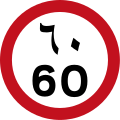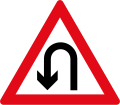This article needs additional citations for verification .(May 2021) |

Road signs in United Arab Emirates are modelled on the British road sign system [1] that are regulated by the Road Traffic Authority (RTA) Dubai and Department of Transport (DoT) Abu Dhabi. The English language typeface is Transport and the Arabic language typeface is Naskh. [1]

















